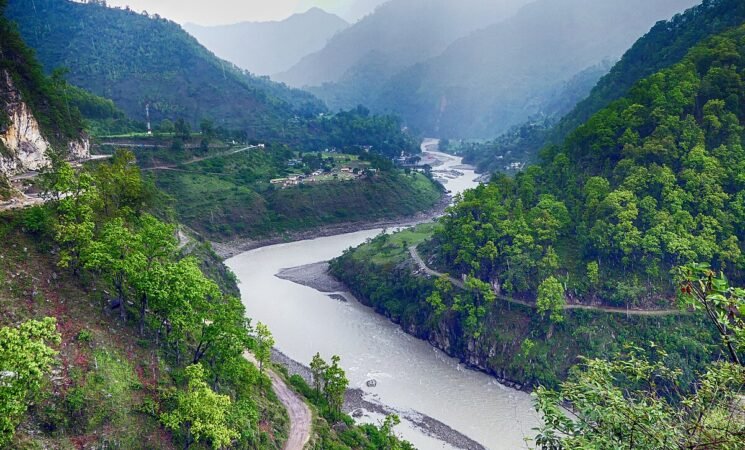29 June 2025, NIICE Commentary 11378
Ammu S Anil
Introduction
The Mahakali Treaty is regarded as the most ambitious yet contentious agreement between Nepal and India. It was the first bilateral treaty on water resources signed following the dissolution of the Panchayat system and the introduction of a Constitutional Monarchical Multiparty Parliamentary system in 1990. Several provisions within the treaty have remained a subject of ongoing debate and conflict among various stakeholders, including political parties in Nepal. Even after more than twenty years since its implementation, the treaty has seen no substantial progress in fulfilling its commitments. Instead, it has led to a deadlock in water relations between Nepal and India. The Mahakali River serves as a border river marking the Western boundary between Nepal and India. However, there is a longstanding dispute between the two states regarding its point of origin. Nepal asserts that the river's primary tributary originates at Limpiadhura and should be considered the main stem of the Mahakali River. In contrast, India claims that its source is the Lipulekh Glacier. The Mahakali basin covers a total area of 15,260 km², with 34 per cent of it located in Nepal. Within Nepal, the basin spans four districts in the Sudurpaschim Province: Kanchanpur, Baitadi, Darchula and Dadeldhura. While political relations between India and Nepal have generally remained stable over the centuries, their cooperation on water resource development along shared rivers has been less harmonious. The two states have long been entangled in disputes over water-sharing arrangements for major rivers that originate in Nepal and flow into India.
Issues of contention
One of the key reasons for these disagreements is the lack of specificity in existing treaties, which has led to ambiguity in their interpretation and implementation. Moreover, the focus of these treaties has varied based on the most pressing issues at the time of negotiation. They address a range of topics, including catchment area ratios, land development ratios, investment shares, riparian rights, and the valuation of water, though to differing extents. The Mahakali River, an international river flowing from Nepal into India, further complicates these challenges, as it also serves as a border between the two countries for significant stretches, intensifying disputes over its governance and usage. Water is one of the most plentiful resources on Earth, but less than 1 per cent of the entire quantity is consistently accessible for human use. Water legislation in India includes international treaties, as well as federal and state statutes. It also encompasses several informal agreements, including water-related policies and customary rules and regulations. Non-governmental organisations in India express apprehensions over some stipulations of the National Water Policy 2002. This approach did not take into account the distinctiveness and diverse agro-ecological zones of each state.
This paper argues that water democracy in India needs to be achieved and that there is a need for a basin-wide approach, as every river in South Asia has different socio-economic and political contexts. India and Nepal share rivers, valuable freshwater resources, creating competitive hydro political dynamics between riparian nations. Rivers traverse international borders, influencing political corridors and influencing the Ganges Basin. The role of politics also determines the rivers’ flow and progress, as well as the 100-year-old river diplomacy between India and Nepal, showing the political history of the conflicts as well as cooperation.
India-Nepal water relations
India appears to have a long-term approach in its water resource negotiations with Nepal, strategically aiming to gain control over Nepal’s major rivers and initiate projects as needed. In contrast, Nepal has yet to formulate a comprehensive strategy regarding India and has primarily been reactive to India's proposals and actions. Additionally, water-related issues in Nepal have become highly politicised and sensitive. Despite the existence of multiple committees at various levels to address water resource concerns, the relationship between the two countries remains unsatisfactory. These committees do not convene regularly, even when pressing matters require immediate attention. Many unresolved issues depend on joint political decisions, and without such cooperation, the deadlock is unlikely to be resolved. Consequently, Nepal–India joint institutions responsible for implementing the provisions of the Mahakali Treaty have not been functioning effectively.
Critical Analysis
The key issues remain unresolved, including whether irrigation water from Lower Sarada Barrage should be classified as existing use, whether Dodhara-Chandani area water should be considered post-Pancheshwar, and whether 5 percent annual flow reserved for future use should be factored into PMP planning. While the project could have helped address regional imbalances in tangible benefits, it has also led to the loss of intangible benefits, such as the overall development of Nepal’s Far West region and enhanced cooperation in water resource management between the two states. Since the recognition of downstream benefits in a treaty between Nepal and India for the first time through the Pancheshwar storage project, successfully reaching an agreement and executing the project could establish a strong precedent. This would be valuable for future storage projects, such as the Karnali Chisapani and Koshi High Dam projects.
Challenges
The delays in implementing the Mahakali Treaty can be attributed to several factors, like the controversies surrounding the agreement and its ratification, then India’s strategy to legitimise unilateral construction and finally Nepal’s unclear position on securing its benefits. The treaty offers various advantages, including benefits in power generation, irrigation, and flood control. However, the impacts of these benefits on Nepal can be categorised as both tangible and intangible. One of the key reasons for the limited utilisation of hydropower potential from the transboundary rivers between Nepal and India is the significant difference in their priorities and the division of project benefits. While Nepal was eager to launch the Karnali Project, India preferred to focus on the Pancheshwar Project. Ultimately, the primary cause of delays in the Mahakali Treaty’s implementation lies in the controversies over its signing and ratification, which have led to differing interpretations of its provisions.
Conclusion
As nations increasingly depend on large dams along shared rivers to counteract the effects of climate change, international water law plays a crucial role in ensuring the equitable and reasonable use of water resources. Additionally, it addresses complex benefit-sharing arrangements between states and navigates power imbalances within river basins. This legal framework can support weaker riparian states in resisting hydro-hegemony, fostering greater cooperation in managing transboundary water resources. Indian policymakers recognise that projects like the Pancheshwar and SKSK dams hold strategic importance due to their potential for transformative impacts, as highlighted by a former Indian Ambassador to Nepal. The Pancheshwar dams are expected to contribute significantly to the agricultural economy of the Ganges plain. Facilitating smooth negotiations, Indian officials should prioritise generosity towards neighbouring countries.
Recommendations
Overcoming the current deadlock in implementing the treaty, the following recommendations can be considered. Firstly, reach a political agreement on cost-sharing without debating whether the Lower Sarada system falls within the treaty’s scope. Secondly, proceed immediately with the implementation of the Chandani-Dodhara irrigation system. Thirdly, ensure that Nepal retains the right to withdraw as much water as needed in the future, beyond the currently identified projects. Fourthly, guarantee India’s right to utilise downstream water flow without disputes or restrictions.
Ammu S Anil is a Visiting Fellow at NIICE and enrolled as a Senior Research Fellow in the MMAJ Academy of International Studies at Jamia Millia Islamia, New Delhi.

